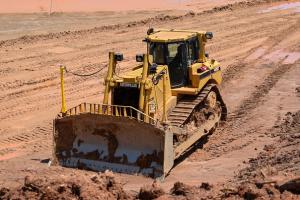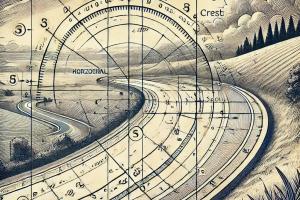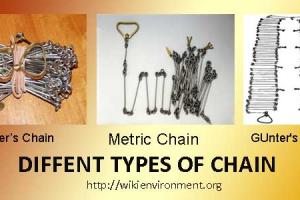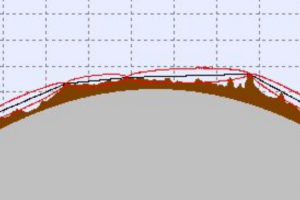Surveying Dictionary Words Definitions Starting from M, N, O, P
Magnetic Declination
Magnetic declination is the horizontal angle between true north (i.e., the geographic meridian) and magnetic north (i.e., the magnetic meridian). There are two conventions for specifying the angle. One is to indicate the magnitude (e.g., 6o) and direction as E or W of north. The other considers positive values to be toward the east and negative values to be toward the west. Magnetic declination is dynamic. It changes over time as the earth's magnetic field changes. There is a more or less orderly tendency to shift about the same amount per year (as much as 5-10 minutes!). There are also cyclical fluctuations on yearly (about 1') and daily (about 8') periods. The direction and rate of drift vary over time, so you should use information on magnetic declination and drift from as close to the time of a survey as possible. Long term records from London show a variation of 16 degrees over four centuries.
Magnetic declination is usually indicated on maps in the area of the legend.
Map
A representation of the earth's surface where constituencies and related nomenclature are portrayed to a specific format.
Map projection
A means of systematically representing the meridians and parallels of the earth onto a plane surface.
Map scale
The relationship between a distance on a map and the corresponding distance on the earth's surface.
Map Data
Digital data that has a spatial component. Typically these are digital maps but can also include data that has some form of spatial attribute that can be linked to a real world location - i.e an address.
Mark
An object, for example an imprinted metal disc, used to designate a survey point. It is usually associated with terms such as reference mark, azimuth mark or bench mark.
Measuring scales
Measuring scales allow the user to represent a subject or drawing to a recognisable reduction or constant ratio of the actual or proposed size. Many early scales were made of silver, ivory, bone or boxwood.
Meridian
A straight line connecting the North and South Poles and traversing points of equal longitude.
Meridian
A north-south reference line. It may be taken through the position of the instrument, or, in special cases, through a reference point (such as the Royal Observatory in Greenwich, England, which designates the Prime Meridian - 0o longitude).
Minor land cover/uses.
See Other rural land. A miscellaneous group of land cover/uses that is sometimes used in NRI tables and reports but not in data collection.
Object Orientation
A data model that treats components of a program or database as individual entities. These 'objects' encapsulate knowledge about how the entity responds and reacts to the system and inherits functionality from generic classes of objects.
Object-Based Data
Data in which one entity (i.e. one feature) represents one real world object (e.g. a building or land parcel).
Occupied Point
The physical point over which the instrument (level, transit, total station, etc.) is set up. It is the point from which any measurements taken while at that point are reckoned. Often abbreviated in notes as OC.
Order of Leveling
Orders of levelling refer to the quality of the levelling, usually being defined by the expected maximum closing error. These are given in Table
|
Order |
Purpose |
Maximum close |
|
Precision order |
Deformation surveys |
0.001 x km |
|
First order |
Major levelling control |
0.003 x km |
|
Second order |
Minor levelling control |
0.007 x km |
|
Third order |
Levelling for construction |
0.012 x km |
Orientation
Orientation of a point or a text feature measured in degrees anticlockwise from grid east.
Origin
The zero point in a system of rectangular Cartesian coordinates.
Orthogonal
At right angles to each other.
Orthophoto
Photographic image, rectified to remove the distortions caused by variations in terrain height, resulting in an image in which all pixels are to the same scale.
Other aquatic habitats
Includes wetlands and deepwater habitats occurring in the Riverine, Lacustrine, or Marine Systems, and deepwater habitats occurring in the Estuarine System as defined by Cowardin et al. 1979 (see Wetlands).
Other rural land
A Land cover/use category that includes farmsteads and other farm structures, field windbreaks, barren land, and marshland.
Ownership
The separation of federal and nonfederal lands and the distinction between administrative units of land. Water areas are not classified according to ownership.
Orders of Surveys
The order of a survey is a way of expressing the accuracy of the work. The order of the survey can have two levels of designators, namely, Order and Class.
Overhaul
The process of refashioning the old County Series 1:2500 scale maps to adequate National Grid standards. It included the adjustment of the detail on the old maps to the control points of the 1936 retriangulation, the recompilation of the maps on the national Transverse Mercator Projection and with sheet lines corresponding to the National Grid., the elimination of errors (particularly those caused by distortion of materials and inadequacy of old revision methods), the revision of detail and finally, the fair drawing of all maps to a new specification.
Pacing
Pacing is a "quick and dirty" method for estimating distances. One simply walks from one point to another, counting steps. Knowing the length of one's step allows a quick estimation of the distance. With practice, pacing estimates will typically be accurate to within 2%. Pacing is most reliable on even terrain without obstructions.
Paradigm
A set of assumptions, concepts, values and practices that constitutes a way of viwing reality for the community that shares them, especially in an intellectual discipline.
Parallel
A line of latitude.
Parameter
A quantity that is fixed for the case in question, but may vary in other cases.
Perennial stream
A stream or reach of a stream that normally flows continuously .
Personal Digital Assistant (PDA)
A hand-held, computer-assisted survey collection tool used to record NRI data.
Photogrammetry
The science, art and technology of obtaining reliable measurements and maps from aerial photographs.
Photographic interpretation
The act of examining photography images for the purpose of identifying objects and judging their significance.
Pixel
A picture element of a raster image as displayed on a screen or raster plot. Platform Independent A term usually applied to a piece of software that can operate on many different hardware platforms e.g. PC, Unix, Mac, VAX etc.
Plane Surveying
Plane surveying is a subset of the general field of surveying in which it is assumed that a Cartesian coordinate system is applicable or appropriate. The methods of plane surveying are appropriate for most construction and planning tasks that are relatively small in scale. Plane surveying is used to approximate the conditions on small portions of the surface of the earth (which is, of course, spherical).
Plumb Bob
A plumb bob is carefully machined, pointed weight that is suspended with a string. It is used to indicate a (local) vertical line through the point of suspension. Plumb bobs are commonly used for locating an instrument precisely over a fixed point or to project a vertical line between a tape and a point on the ground.
Plot
The provision of an extract of the data as a single plot or print on paper or similar medium.
Point
A zero-dimensional spatial abstraction of an object represented by a coordinate pair.
Point and Line Data Structure.
A form of vector data structure designed for map production in which all map features are designated as points or lines or text. Point and line data does not carry the topological relationships between features.
Point Feature
A zero-dimensional spatial abstraction of an object with its position defined by a coordinate pair. Points may also be represented by symbols which may have attributes such as orientation and size.
Polygon
Polygons are representations of areas. A polygon is defined as a closed line or perimter which completely encloses a contiguous space and is made up of one or more links. At least one node occurs on the perimeter of a polygon where the bounding link completes the enclosure of the area. There may be many nodes connecting the bounding links of a polygon. Links may be shared between polygons. Polygons ma wholly contain other polygons; or be contained within other polygons.
Polygon Boundary
The link or links which enclose a polygon, projected into the horizontal plane.
Polyline
A line made up of a sequence of line segments.
Positional Accuracy
The degree to which the coordinates define a point's true position in the world, directly related to the spheroid and/or projection on which the coordinates system is based.
Positional Quality Gives an indication of the positional accuracy of the location coordinates in ADDRESS-POINT.
Precise Leveling
Precise levelling is a particularly accurate method of differential leveling which uses highly accurate levels and with a more rigorous observing procedure than general engineering leveling. It aims to achieve high orders of accuracy such as 1 mm per 1 km traverse.
Primary sample unit (PSU)
An area of land, typically square to rectangular in shape, that is approximately 40, 100, 160, or 640 acres in size. Within the PSU, sample points are assigned. Certain data elements are collected for the entire PSU, while others are collected at the PSU points.
Prime farmland
Land that has the best combination of physical and chemical characteristics for producing food, feed, forage, fiber, and oilseed crops and is also available for these uses.









